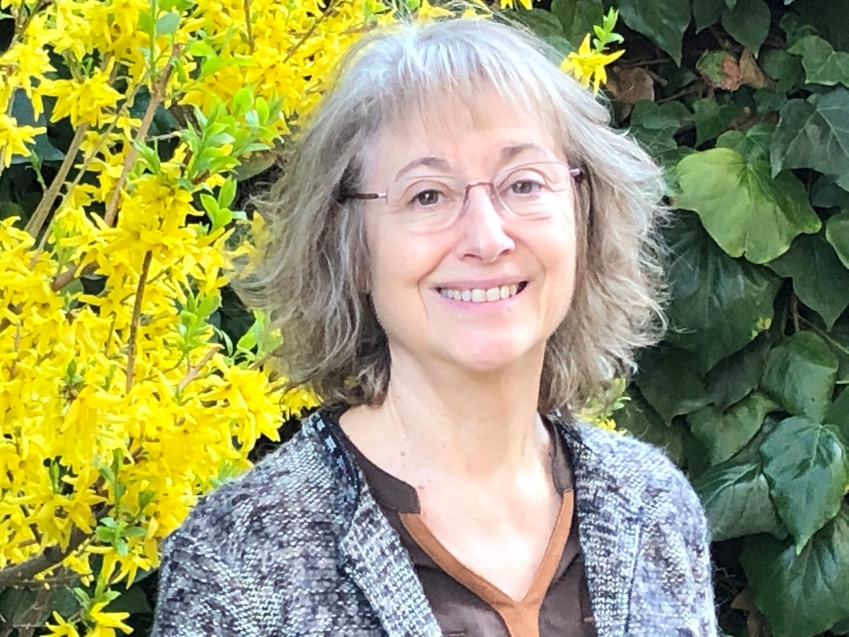News

Interview series with RILEM prominent members: Dr Carmen Andrade
Interview with Dr Carmen Andrade, CSIC, Spain
Dr Carmen Andrade was a Research Professor at the National Research Council of Spain (CSIC), Institute of Construction Sciences “Eduardo Torroja”, Spain. She is currently a Research Visiting Professor at the International Centre for Numerical Methods in Engineering (CIMNE). She was awarded the Robert L’Hermite medal in 1987 and in the same year she became TAC chair. She became RILEM Fellow in 1995 and she was elected RILEM Vice-President in 1997. Dr Andrade took over the mandate as President in 2000. From 2003 to 2006 she served as Immediate Past President of RILEM. She also acted as TAC convener from 2003 to 2008 and she was member of EAC from 2010 to 2015. She chaired the following RILEM TCs: 154-EMC Electrochemical techniques for measuring metallic corrosion in concrete, 178-TMC Testing and modelling chloride penetration in concrete, 213-MAI Model assisted integral service life prediction of steel reinforced concrete structures with respect to corrosion induced damage. She became RILEM honorary member in 2015.
3 December 2021
RILEM Implementation Manager (RIM): Hola Carmen, gracias para estar conmigo hoy. ¿Podemos seguir la entrevista en Ingles? Hi Carmen, thank you for being with me today. Can we continue the interview in English?
Dr Carmen Andrade: ¡Claro que si! Of course, we can!
RIM: ¡Perfecto, gracias! Pero también me gustaría traducir esta entrevista en Castellano. Perfect, thank you! But I would also like to translate this interview into Spanish.
Dr Carmen Andrade: Por supuesto. Si quieres, la traduzco yo. For sure! If you like, I will translate it!
RIM: ¡Muy agradecida, Carmen! Lo mismo hicimos con Emilio Martinez Pañeda este año, uno de los dos Medallistas Colonnetti. I am so grateful. We did the same this year with Emilio Martinez Pañeda, one of the 2 Colonnetti medallists.
Dr Carmen Andrade: La he leído. Por cierto… Emilio es un investigador fantástico. Debería haberse presentado para el Robert L’Hermite, sin duda. El tema de su investigación es complicadísimo. A mi me ha contestado muchísimas preguntas. De hecho, he estado en contacto con él por correo porque llevaba muchos años preguntándome cosas que el tiene respondidas en su trabajo. Es Fantástico, lo digo para que los sepáis. Realmente es un chico muy prometedor que debería ser incorporado al TAC… es lo que hicieron conmigo… I've read it. By the way... Emilio is a fantastic researcher. He should have applied for the Robert L'Hermite, no doubt. The subject of his research is very complicated. He has answered a lot of my questions. In fact, I have been in contact with him by mail because I had been asking myself for many years things and he found the answers in his work. It's fantastic, I want you to know it. He really is a very promising guy who should be incorporated into TAC... it's what they did with me...
RIM: Exactly YOU! Let’s talk about you, now! You are a former RILEM President, one of the only two female RILEM Presidents. The system tells me that you became RILEM Vice President in 1997. What happened before then?
Dr Carmen Andrade: I joined my institute (Editor’s note: the Institute of Construction Sciences “Eduardo Torroja” (CSIC), Spain) in 1969. My institute was member of RILEM at that time (Editor’s note: Eduardo Torroja was one of the founders of RILEM in 1947). The delegate of RILEM was CEDEX - Centro de Estudios y Experimentación de Obras Públicas, Spain – but my supervisor, Prof Jose Calleja, was an active member of RILEM in the technical Committee dedicated to study sea water attack. I was really fascinated, when listening to Dr Calleja, about the work in RILEM. I had in mind that as soon as I could, I should become a member. I did not become an official staff member in my institute until 10 years later, as you have to apply to become a staff member, you have to finish your thesis, etc… I became permanent staff at CSIC in 1979 and I straight away asked my director to become a RILEM member. By then, the committee I mentioned before of Dr Calleja had finished. A new committee was starting, for the corrosion of steel in concrete (Editor’s note: TC-60 Corrosion of steel in concrete), chaired by Peter Schiessl. In that case, I was attending the TC meetings from its start. I remember I attended a meeting during a workshop in Saint-Rémy-les-Chevreuse (Editor’s note: “Alteracion et durabilite des betons et des Pierres”, November 1981, organised by Centre Scientifique et Technique des Materiaux - CSTM) led by Prof Tassios. Prof. Tassios was RILEM President in 1978 and he is an incredible person. I was attending a seminar in durability, that was my first RILEM course and TC meeting. Through the committee of Peter Schiessl I learned a lot. Other TC members were Chris Page, Robert Bakker, Kyösti Tuutti, Hans Arup… I mean, there was a group of 5-7 people with whom I had a lot of meetings, we enjoyed a lot the discussion. An outcome of those meetings was a RILEM “green” book (Editor’s note: “Corrosion of Steel in Concrete, Report of the Technical Committee 60-CSC RILEM”, P. Schiessl, Editor. 1988, Chapman and Hall: New York). I really engaged in that work. All my expectations were fulfilled, completely! I started to be invited to the General Council. Then I received the Robert L’Hermite medal in 1986. I became to be an active member. There were 3 or 4 women at that moment. I have always been very much stimulated by the RILEM meetings. There you can meet in person the people whose work you read in international journals and they were for me such good people, so advanced and creative that I have always thought that RILEM is a source of new ideas. Would you like to know where is the frontier of knowledge? You need to attend one of the RILEM events. I have always kept my engagement and I hope to maintain it for many more years to come.

Some members of TC-60. From the left: R. Bakker, O. E. Gjørv, K. Tuutti and P. Schiessl. Picture courtesy of C. Andrade.
RIM: You joined RILEM in the late 80ies and became RILEM Vice President in the late 90ies. What happened in between?
Dr Carmen Andrade: I think that in those years the General Secretary was a key-person in the organization. When I joined, this person was Maurice Fickelson. We were very good colleagues. He was respecting very much my Institute because Eduardo Torroja was one of the founders and Presidents of RILEM. Same with the next General Secretary, Michel Brusin. I am convinced that it was either Maurice or Michel that “discovered” me and proposed me to the Bureau. Prof. Folker Wittmann was the President of RILEM when I was elected Vice-President after a voting process over 3 candidates.
RIM: According to the records, you became Vice President when Jacques Bresson was President and Folker Wittmann was Out-going President.
Dr Carmen Andrade: Ah, ok! Let me add something to this: as soon as I became Robert L’Hermite medallist in 1986, I was proposed to become TAC Chair and so I did. Before being elected Vice-President, I had sat in the Bureau. I was very familiar with RILEM and its structure.

Award ceremony of the 1986 Robert L’Hermite medal at the 40th RILEM General Council in Bologna, Italy, showing C. Andrade (1986 medallist) presenting her research. Picture courtesy of C. Andrade.

Award ceremony of the 1989 Robert L’Hermite medal. From the left: M. Fickelson (General Secretary), F. de Larrard (1989 medallist), C. Andrade (TAC chair) and E. Giangreco (RILEM President). Picture courtesy of C. Andrade.
RIM: How was RILEM in those days? Much different from the association it is today?
Dr Carmen Andrade: In the early times, RILEM had to nominate delegates in each country with the job of promoting the association. In Spain it was CEDEX. CSIC was a member. Everything was much more formal. The General Council lasted for 2 or 3 days, only delegates were invited to attend and it was very administrative. On the other side, TAC, DAC and Bureau were much more technical. When I joined, RILEM had already decided that TCs must have a short life. The only permanent committee was the one on “concrete” (Editor’s note: TC 14 - Concrete permanent committee). The TCs were very alive but their activities were outside the agenda of the General Council. I learned lots of skills while sitting in the General Council, like for instance, diplomacy and international relations. I remember we spontaneously gathered a small group of people during lunches and dinners made of myself, Arnon Bentur, Ake Skarendahl, Duncan Pomeroy who was the UK delegate, discussing the need to change this aspect of RILEM. This was a process that ended in 2002, when I organised the RILEM Annual Week in Spain and when we finally changed the format of the General Council. That was the first RILEM event in which the focus was on a workshop or seminar and in which the length of the General Council was significantly shrunk. Mr. Brusin was not completely happy about this change, because by reducing the time dedicated to the administrative issues, you somehow make the General Secretary less powerful. It was not easy.

Participants of the 2002 RILEM General Council in Madrid. Picture courtesy of C. Andrade.
RIM: Beside your stellar career in RILEM, you have also been a very successful professor. In particular, you had been Director of the Institute of Construction Sciences “Eduardo Torroja” (CSIC) between 1985-1988 and 1993-2003. You also were the first (and only) female Research Professor in CSIC between 1987 and 2000 in the Materials Department.
Dr Carmen Andrade: … and in 1997 I was also the President of the European Union for the Technical Agreement in the Construction (UEATC). I have two older brothers and one younger one. I have always thought that this was the reason. I was the only girl between my brothers and my parents were always pushing me by saying “You are as strong as your brothers. Don’t be afraid”. They said this because I thought they were always going to win in games and competitions, but my parents were telling me “You need to be the same. You have the same rights, and you need to develop your life as they are”. For this reason, it was completely natural for me, although still surprising, to be the only woman in many places. Education of girls is essential to develop their talents with no limits due to the gender.
RIM: Let’s move into a more technical question now. What would be the major outcomes of your work that would be of interest to RILEM members and the most impactful paper that you have published in Materials and Structures?
Dr Carmen Andrade: Well, I think there has been a technical committee that I chaired that has been very important: it is 154-EMC Electrochemical techniques for measuring metallic corrosion in concrete, that published 3 recommendations on corrosion. Precisely, I am applying to update those recommendations and we have finished the preliminary stage to have a new RILEM TC approved with this purpose. The members of that TC had background in physics, chemistry, corrosion. Now, most of the people working on corrosion in RILEM are civil engineers so I have the feeling that the background has been lost. I find myself in the need of repeating basic concepts for people to understand what they are doing. The most cited papers I published in MAAS are the ones in which we test the evolution of cover cracking due to corrosion. With the collaboration of a colleague (Javier Molina, then a student and at present in ISPRA Research Centre) we did a first numerical modelling of the process of cracking induced corrosion (Editor’s note: 1) Andrade, C., Alonso, C. & Molina, F.J. Cover cracking as a function of bar corrosion: Part I-Experimental test. Materials and Structures 26, 453–464 (1993); 2) Molina, F.J., Alonso, C. & Andrade, C. Cover cracking as a function of rebar corrosion: Part 2—Numerical model. Materials and Structures 26, 532–548 (1993)).
RIM: RILEM encourages people with different background from civil engineering to join, as it values a multidisciplinary environment. On this matter, you hold a PhD in Industrial Chemistry, if I am not wrong.
Dr Carmen Andrade: Yes, I do. Multidisciplinary means also to be ready to learn concepts that are outside your comfort area. It is important to enlarge the knowledge by attending courses and learning new things, no matter how old you are. In another TC I chaired on chloride modelling (TC-178-TMC -“Testing and Modelling chloride penetration in concrete”) we established that the modelling of corrosion, especially when it comes to chloride attack, is very uncertain. When we started that TC, there were people thinking that with the equation of Fick’s law they had solved the problems of corrosion and it is not like this! Twenty years later it is clear that it is not like this. Still many uncertainties remain when using predicting models as they are not calibrated long enough. The joint work of material and structural specialists is essential.
RIM: I like this initiative of updating the recommendations of TC 154-EMC. A TC is like a crime scene, a place where you have many questions, but you do not necessarily find the answers… or the murderer.
Dr Carmen Andrade: Yes! This is a characteristic of RILEM and what I really like about it. RILEM is a place where you find the people with the questions. These are not people trying to demonstrate that they know it all, but that have lots of questions. This is what is important in science: to have the right question and to look for the answers.
RIM: Where do you see RILEM is going in the future?
Dr Carmen Andrade: When I left the Presidency, I decided to not give any public opinion about the work of the following Presidents, as a proof of my respect towards them. They are doing very well, any way! I trust they will have a better view about the organization than I have now. Regarding the thematic areas, I totally agree with Johan (Editor’s note: Johan Vyncke, RILEM President in 2015-2018, discussed the importance of certain topics at the last RILEM Strategy Workshop. His presentation is available here). I think that low carbon cement, circular economy, and durability are fundamental topics. Low environmental impact is not only reducing the CO2 emission but also minimising the expenditure of resources. That means that our buildings and infrastructures have to last longer. RILEM should play a strategic role in the bridge between the very basic research and applied science. Another aspect that should be very important for RILEM is to join the UN Sustainable Development Agenda with an official declaration of support towards this initiative. It can even be a joint action with the new Joint Committee on the GLOBE Consensus under the Liaison Committee of International Associations of Civil Engineering.
RIM: Thank you so much, Carmen. It was great to talk to you today.
Dr Carmen Andrade: Thank you.
 1
1













No comment
Log in to post comment. Log in.